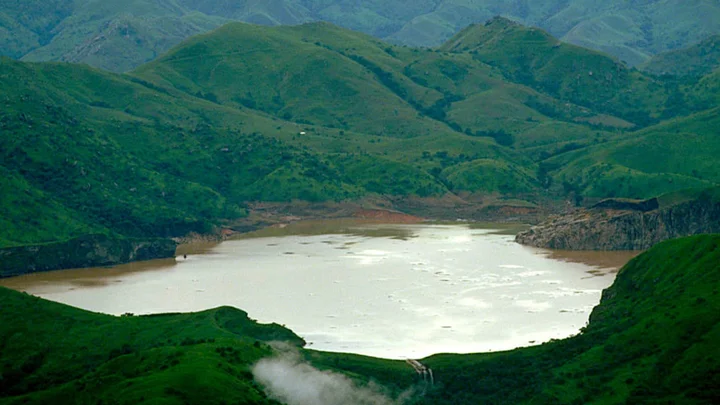On August 21, 1986, a man making his way to Nyos, a village near a crater lake in northwest Cameroon, found dozens of dead animals along the road. He called into a home to see if the residents knew what had happened. Instead of getting answers, the man discovered that everyone in the village was dead, though they seemed otherwise unharmed.
Within days, officials confirmed that more than 1700 people in Nyos had died, along with several thousand animals. Local authorities were unsure what caused the disaster. But the strange and tragic event seemed similar to one that occurred two years earlier, just 60 miles to the south.
At Lake Monoun, on August 15, 1984, villagers found 37 people and many animals dead along its shores. Initially, authorities were baffled about the cause and even suspected domestic terrorism. They interviewed witnesses who reported hearing rumbling sounds and seeing a sudden rise of a strange white cloud from the lake, which quickly dissipated.
The Lake Monoun tragedy had puzzled geologists and local officials, but the disaster at Lake Nyos caught the world’s attention. Scientists from around the globe gathered in Nyos to investigate. Because Lake Nyos sits on a dormant volcano, their first theory was that the volcano had erupted and sent poisonous gases into the air. After further research, they found the cause was much more unusual.
The deadly events at Lake Monoun and Lake Nyos were both extremely rare natural disasters called limnic eruptions.
What Are Limnic Eruptions?
The two events in Cameroon are the only recorded instances of limnic eruptions. Although deadly and objectively terrifying, limnic eruptions are extremely unlikely because they require a specific combination of factors to occur—factors that happened to be found at Lake Monoun and Lake Nyos in the 1980s.
Also called lake overturn, a limnic eruption occurs when dissolved carbon dioxide (CO2) suddenly erupts from the deep waters of a lake, forming a deadly gas cloud above the surface. Because carbon dioxide is heavier than air, the cloud will sink toward the ground, suffocating wildlife, livestock, and humans.
Limnic eruptions occur in places where there is a high concentration of carbon dioxide in the water. The CO2 can be created by various geological processes, but the most common source is volcanic gases from Earth’s magma that have moved upward.
Carbon dioxide can dissolve more easily in areas with high pressure, such as the deep, cold parts of lakes. As a result, the bottom of deep lakes can have very high levels of carbon dioxide, while the levels decrease towards the lake's surface. Limnic eruptions are only likely to occur in stratified lakes, which means that the water stays in layers that rarely mix, keeping the CO2 stuck at the bottom while the pressure builds and builds.
Any changes in temperature or pressure can trigger the rapid and forceful release of the accumulated carbon dioxide from the lake's water, causing an eruption. It is unclear what triggered Lake Monoun and Lake Nyos to explode, but considering both lakes’ proximity to the Oku Volcanic Field, it is possible that an earthquake or small volcanic eruption occurred before each disaster. We may never know exactly what caused them.
Averting the Next Limnic Eruption
After studying the chemical composition and geology around Lake Monoun and Lake Nyos, experts concluded that the eruptions were made possible by carbon dioxide building up in the cold waters at the bottom of the lakes, pressure increasing, and gases eventually exploding like a can of shaken-up seltzer. Researchers’ attention turned to identifying other lakes with the right ingredients for limnic eruptions and preventing the disasters from happening, focusing on Lake Kivu on the border of Rwanda and the Democratic Republic of the Congo.
Lake Kivu, just south of the very active Nyiragongo stratovolcano, contains high amounts of carbon dioxide that doesn’t dissipate at the surface. These factors put the lake at risk for a limnic eruption in the future. But scientists have an advantage now, thanks to research conducted after the Lake Monoun and Lake Nyos eruptions.
Starting in 1992 at Lake Monoun and in 1995 at Lake Nyos, researchers began experimenting with degassing methods, a process that involves installing a pipe into the CO2-rich layers of the lake and allowing the water to jet out like a fountain at the surface, harmlessly dissipating the gas [PDF]. For testing, they used special tubes with sensors and control valves anchored on a floating raft in each of the lakes. This setup allowed experts to monitor the slow and safe release and avoid an explosion.
They started full-scale degassing in 2001 at Lake Nyos and in 2003 at Lake Monoun. Another pipe was installed at each lake a few years later, and the efforts successfully reduced the bodies' CO2 levels, making devastating explosions less likely in the future.
Scientists now have a better understanding of how potentially lethal amounts of gas accumulate in lakes and the likelihood for catastrophic limnic eruptions. Lakes Monoun and Nyos still serve as natural laboratories for developing new investigation methods and equipment to watch for—and prevent—similar disasters.
Related Tags
ANIMALS WATER GEOLOGY HOME SCIENCE How On Earth TERRORISMEditor's Picks
8 Weird Disasters from History
Bleep This: A Brief History of Profanity on Television
Thanks to a Privacy Breach, Facebook May Owe You Some Money—But You Have Just a Week Left to Collect
7 of the Best Cat Litter Boxes, According to Experts









